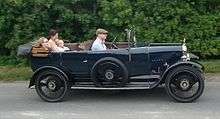Alvis 12/50
| Alvis 12/50 | |
|---|---|
.jpg) SA, 2-seater 'duck's back' body by Carbodies, despatched November 1923 | |
| Overview | |
| Manufacturer | Alvis |
| Production |
1923-1932 3705 made [1] |
| Powertrain | |
| Engine | 1496, 1598 or 1645 cc Straight-4 overhead valve |
| Dimensions | |
| Wheelbase | 108 in (2,743 mm) (SA) or 112 in (2,845 mm)[2] |
| Length | 153 in (3,886 mm) to 158 in (4,013 mm)[2] |
| Width | 60 in (1,524 mm)[2] |
| Chronology | |
| Predecessor | Alvis 10/30 |

The Alvis 12/50 is a car introduced by British business Alvis Car and Engineering Company Ltd in 1923. It went through a series of versions, with the last ones being made in 1932. A range of factory bodies (made by Carbodies and Cross & Ellis) could be specified in two- or four-seat form, with either open or closed bodies.
The subframe cars
SA and SB
The first 12/50s were produced in late 1923 for the 1924 model year. The cars from this first year of production were designated SA and SB, and had a 1496 cc 4-cylinder overhead valve engine in a chassis with a wheelbase of 108.5 in (2,756 mm) for the SA, and 112.5 in (2,858 mm) for the SB. The engines of these early cars were carried in a subframe bolted to the relatively slender ladder chassis. The SA usually carried two-seat bodywork, typically the Super Sports 2/3-seater nicknamed "duck's back" because of its pointed rear end, said to resemble that of a duck. The SA and SB 12/50s were built with (twin shoed) brakes on the rear wheels only. All the 12/50s had a four speed non-synchromesh gearbox with right hand change. The cars were right hand drive.
SC
The SC arrived in Autumn 1924 for the 1925 model year with a larger 1598 cc engine (unless the 1496 cc unit was specified for sporting use) and, in most cases, the longer chassis that would be standard for the 12/50 until the end of production. Front wheel brakes were offered as an option on this model.
The 12/50 redesigned
TE and TF
The 12/50 was redesigned for the 1926 model year. From Autumn 1925 a new stronger chassis was used for the TE, which had its engine (now built around a redesigned crankcase) enlarged again to 1645 cc, and the TF of the same year with a short stroke version of the same engine, displacing 1496 cc. A single-plate clutch replaced the previous cone type, and for these and all subsequent 12/50s the engine was bolted directly to the chassis, dispensing with the subframe of previous models. From the TE and TF models onwards four-wheel brakes were fitted as standard. The TE and was superseded for the 1927 model year by the TG. Confusingly, the short-stroke TF was replaced in the 1927 range by a car with an 'S' prefix: the SD.
 TE, Sports Tourer by Cross & Ellis, despatched August 1926 |
 TG, Sportsman's Saloon by Carbodies, despatched January 1928 |
.jpg) SD, two-seater 'beetle back' by Carbodies, despatched September 1927 |
TG, TH and SD
The TG was the standard 'touring' model, while the SD - powered by the 1496cc engine, now fitted with a large-port cylinder head - satisfied the needs of the sporting motorist. Also available in this year was the TH, which had the gearbox and rear axle ratios of the 'touring' TG, but the sub-1500cc engine of the SD. The TG and SD models were available until 1929. The TG and (very rare) TH models can be recognised by their taller radiators, with a noticeably deeper top section. Cars from the 1928 and 1929 model years also sported higher-set lamps, in accordance with the fashion of the time.
The post-vintage years
TJ
The 12/50 was withdrawn between 1929 and 1930 when the company decided that the future lay with the front-wheel drive FD and FE models, but when these did not reach the hoped for volumes a final version of the 12/50 was announced for the 1931 model year as TJ. Fitted with the 1645 cc engine this continued in production until 1932.
The 'post-vintage' TJ is referred to by Alvis historians as being from the 'revival period', and it differs from its predecessor in a number of ways, notably coil instead of magneto ignition, deep chromed radiator shell, and rear petrol tank in place of the scuttle-mounted tank on most older 12/50s.
The TJ was joined in the range by a more sporting version of the same chassis, but this car was marketed not as a 12/50, but as the 12/60. The TK 12/60 was available in 1931, and the TL 12/60 in 1932.
References
External links
| Wikimedia Commons has media related to Alvis 12/50. |